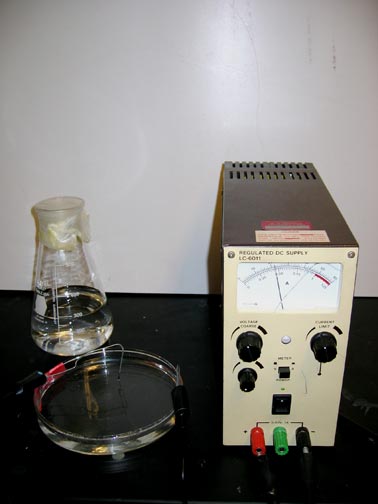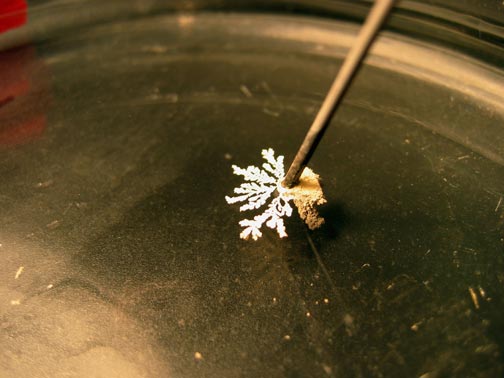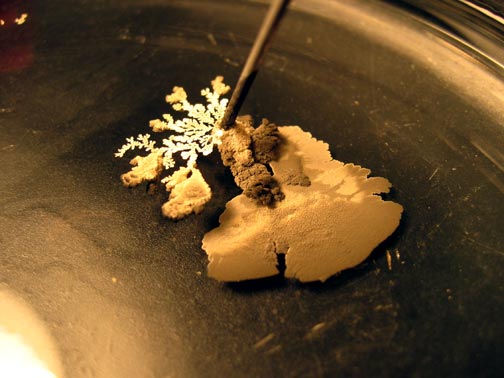The rapid reduction of silver ion forms a fractal "silver tree"
 Voltage is applied across a solution of silver nitrate, and a beautiful "fractal" silver tree is born.
Voltage is applied across a solution of silver nitrate, and a beautiful "fractal" silver tree is born.
Ingredients: ammonia, silver nitrate, evaporating dish, paper clips, voltage source
Procedure: A complete recipe follows.
1. Secure one paper clip to the side of an evaporating dish.
2. Secure a second extended paper clip to the opposite side of the dish.
3. Half-fill the dish with a 0.1M solution of silver nitrate with ammonia.
4. Adjust the end of extended paper clip so that it is just touching the surface of the solution.
5. Apply 22V and observe the reaction.
Understanding: We begin with the dissolution of soluble silver nitrate salt in aqueous ammonia solution. The application of a substantial voltage creates a cathode, lightly touching the center of the solution, and anode, attached to the dish's side. The application of voltage causes electrons to flow to the cathode where they encounter silver ions, reducing the silver ions that deposit on the tip of the cathode as neutral silver metal.
Ag+(aq) + e- → Ag(s)
 The overall process that we exploit is known as electrodeposition. If we were to reverse the voltage across the cell, the silver would be oxidized in the process of electrodissolution. These basic processes are a fundamentally important technology that is used to apply a thin coat of metal to metal or plastic surfaces through the process of electroplating.
The overall process that we exploit is known as electrodeposition. If we were to reverse the voltage across the cell, the silver would be oxidized in the process of electrodissolution. These basic processes are a fundamentally important technology that is used to apply a thin coat of metal to metal or plastic surfaces through the process of electroplating.
The deposition of the silver metal occurs rapidly, creating a "silver tree" that has the dendritic form that we associate with the growth of plants. Branches form, and on those larger branches, smaller branches, and on those smaller branches, still smaller branches form. The structure of the tree seems to repeat itself at a variety of length scales, giving the tree a self-similar or fractal structure. The silver tree is thin and fragile, as the reaction is limited to the surface of the solution.
If the silver ion is reduced in this reaction, what is oxidized? The hint lies at the anode, where we observe tiny gas bubbles evolving from the solution. What is the gas? We can try a bit of sophisticated qualitative analysis by bending over the anode and smelling it. Wew! There is a strong smell of ammonia. Does that mean that it is ammonia gas that is being evolved at the anode? Not at all! If we turn off the voltage and smell the anode again, we still smell ammonia. The ammonia vapor forms above the aqueous ammonia solution, whether the current is running or not.
It is oxygen gas that is formed at the anode, a product of the oxidation of hydroxide ions
2 OH-(aq) → O2(g) + 2 H+(aq) + 4 e-
The ammonia in our solution creates a substantial enhancement in the concentration of hydroxide ion in the solution, facilitating the reaction. This leads to the overall reaction4Ag+(aq) + 2 OH-(aq) → O2(g) + 2 H+(aq) + 4 Ag(s)
Applying LeChatelier's Principle, we can see that making the solution basic drives the reaction forward, while acidifying the solution would drive the reverse reaction.
 What happens if we go wild and increase the voltage dramatically? The rate of migration of silver ions to the cathode increases, as does the rate of deposition of silver at the cathode. When the electrodeposition occurs at a modest pace, the silver growth forms crystals of ordered silver metal. However, when the rate of deposition is increased dramatically, the deposition does not occur in an orderly manner. The deposition occurs rapidly in a way that forms a monstrous blob of silver! The deposit is amorphous and lacks the delicate structure of the crystalline silver tree.
What happens if we go wild and increase the voltage dramatically? The rate of migration of silver ions to the cathode increases, as does the rate of deposition of silver at the cathode. When the electrodeposition occurs at a modest pace, the silver growth forms crystals of ordered silver metal. However, when the rate of deposition is increased dramatically, the deposition does not occur in an orderly manner. The deposition occurs rapidly in a way that forms a monstrous blob of silver! The deposit is amorphous and lacks the delicate structure of the crystalline silver tree.
The amorphous deposit of silver appears less luminous than the crystalline silver, possibly due to the different electronic properties of the two forms of silver metal, and the very different surface properties of the two forms of silver.
If you are fond of your fingers, read this problem
Question: In the electrodeposition of silver, there are two explosive compounds that may be produced. It is important to be aware of this potentially dangerous chemistry.Fulminating silver, Ag2O·(NH3)2, is a black crystalline compound that can be produced when silver oxide is dissolved in aqueous ammonia solution. When the compound dries out, it can explode violently as the result of the most modest disturbance.
Silver fulminate, Ag2C2N2O2, is a white crystalline substance that can be created by adding alcohol to a solution of silver nitrate. It is formed from the association of silver with the fulminate When the compound is dry, it can explode violently.
Draw the Lewis electron dot structure of the cyanate ion, OCN-, and the fulminate ion, CNO-. Use what you know about Lewis structures to explain why the cyanate ion is relatively stable while the fulminate ion is not. Finally, write the balanced chemical reaction associated with the explosion of silver fulminate. Assume that carbon monoxide is a product of the reaction.
You can check your answers here.